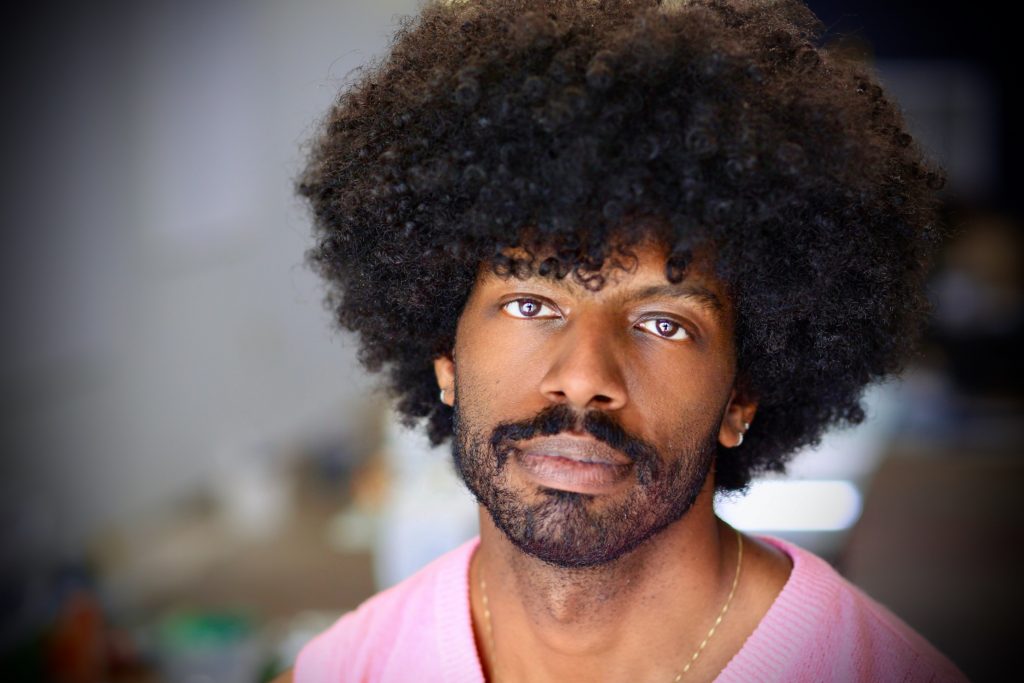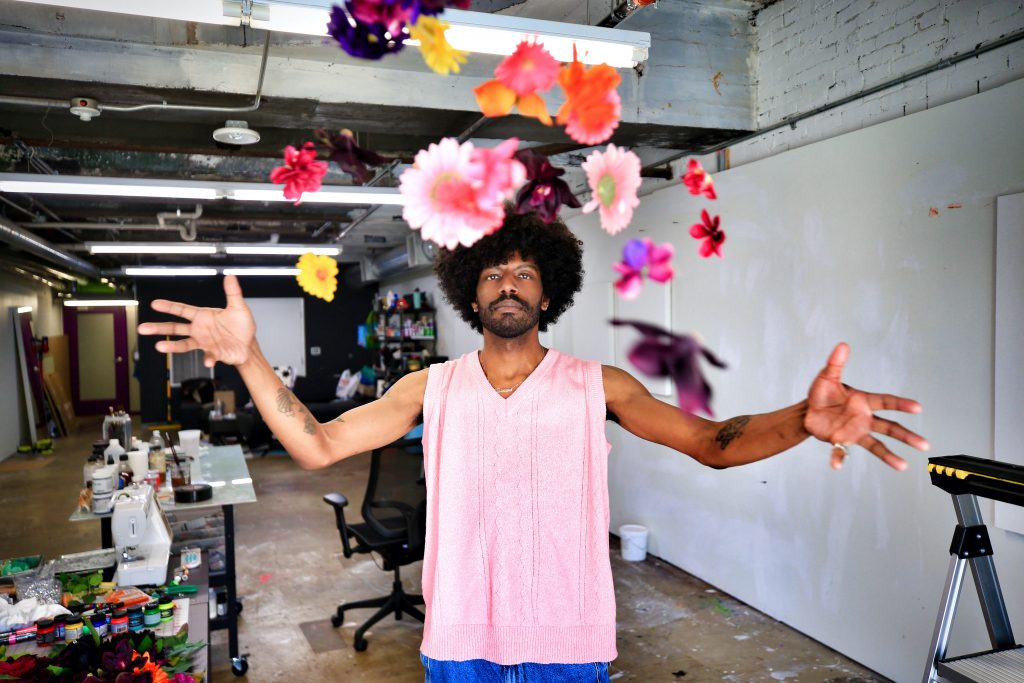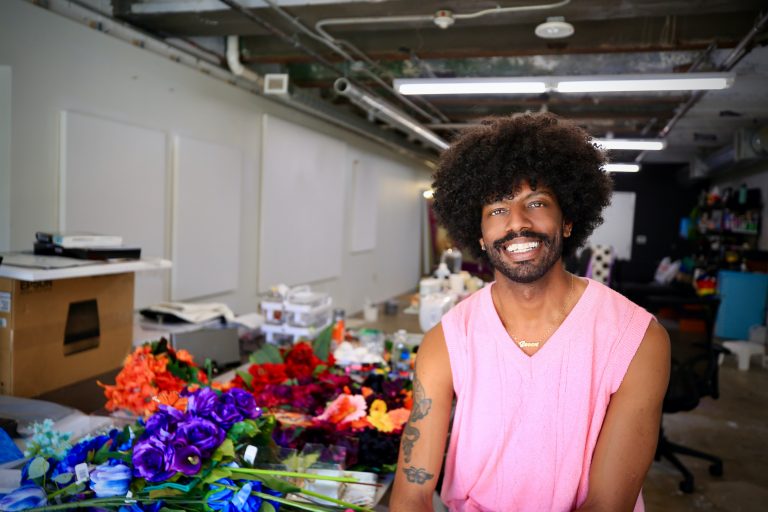Devan Shimoyama’s artwork taps into the natural colors and local flavors of Pittsburgh—while centering Blackness and queerness in traditional spaces.
By Ervin Dyer
Devan Shimoyama is a visual artist and professor at Carnegie Mellon University. His work draws from Africana culture, boldly using glitter, bright ribbon, sparkling jewelry and other material to query what it means to be Black, masculine, queer and human.
In recent years, Shimoyama, only 32, has gained international recognition. In 2018, Shimoyama had his debut solo show, “Cry, Baby,” at Pittsburgh’s Warhol Museum, where he explored homophobia, racial stigma and the hyper-masculine setting of barbershops.
And in November 2021, he premiered “The Grove,” an art installation that was commissioned by the Smithsonian Museum in Washington, DC on the occasion of the reopening of its Art & Industries Building. “The Grove” is part of the exhibition “FUTURES” (on view through July 6, 2022).
“The Grove” pays homage to the collective trauma of the COVID-19 pandemic, political strife and ongoing racial violence. It is inspired by the impromptu urban memorials – tennis shoes flung from utility wires, altars in vacant lots, roadside crosses – he saw in Philadelphia and Pittsburgh.

This conversation with Shimoyama has been edited for clarity and brevity.
For many African Americans, art is all around us, in our homes and our culture. Still, we think we need to go to a museum to see it. As a young man growing up in Philadelphia, how did you begin to recognize art?
I grew up with my mom and my grandparents, who loved to travel to the Caribbean and bring back work from street artisans. They also collected African masks and hung those on the walls. We had a China cabinet, which had tiny ceramic sculptures. Beautiful little blown glass—then there were a lot of family photos. I was surrounded by the arts in a certain way, but I didn’t see it as something that could be a full-on career for me. And I didn’t think of it as being connected to the art world that I navigate through now until much later.
Why do you think young Black people like yourself can’t imagine a vocation as an artist? What is the disconnect?
I grew up thinking art is something that is deeply intimate, something that exists in a home and to be interacted with in a different capacity than something like a museum. This comes from a few things. When I would go to museums, I only saw largely white artists who were dead and then, being introduced to those artists, many of whom struggled and died poor. So, being an artist seemed like a bleak idea. And then I don’t even see any of them being Black. And when you go to a lot of those museums, the idea of Black art is even more ancient: It’s coming from Egypt. So, the idea that art can be local and Black and in a museum was not represented very well when I was growing up.
I use my work to celebrate queerness and Blackness.
Devan Shimoyama

What ideas do you push out with your art?
I use my work to celebrate queerness and Blackness. And my sculptural practice, which leans more into spontaneous memorial, is a way for me to have a cathartic personal healing practice against the larger pressures of being a Black queer masculine person and navigating through America. Too often we see so many Black-identifying people dying from police brutality or being violated or seeing friends who are trans undergo so many horrible injustices. [Spontaneous memorials] are a way for me to process without depicting Black bodies in pain because those types of images circulate so much that they’ve become normalized. But those images are also triggering and hurtful to so many people.
Talk about your use of material.
I’m using craft materials. A lot of sparkly things that might be feminine colors or materials that might be used for gowns or dresses or things that you might see more on a drag queen, or even on a Black lady at Sunday church. These materials are ways in which I can queer something and still have it be embraced by members of the Black community. These materials are sort of a visual syntax that is relatable to a lot of Black-identifying people. The idea of faux luxury and wealth, glitz and glamour, draws them in. As they get closer and start identifying some of these materials, it helps them interrogate the ideas and images of masculinity and queerness.
What other elements do you draw from?
I make work that references music, specifically R&B and hip-hop from the early 2000s when I was growing up. That manifests in my work through sneakers, Timberlands, hoodies and references to Toni Braxton and Rihanna that show up in subtle and more overt ways.
I’m teaching how to approach materiality in a very different way, to think about composition and to think about how to thread research or lived experience and emotion into one’s work.
Devan Shimoyama


Shimoyama’s craft materials conjure faux luxury, glitz and glamour. Photo Credit: Emmai Alaquiva
Are you an activist artist or just an artist?
I think some artists are activists. I would say that I am [mostly] an artist. I have projects that might be more socially charged and engage directly with people who I’m interested in rallying together or talking to. So sometimes I perform as an activist, but, in general, I’m an artist first.
As a professor, what do you teach university students?
In addition to painting techniques, I’m teaching how to approach materiality in a very different way, to think about composition and to think about how to thread research or lived experience and emotion into one’s work. I support students’ natural inclinations, the ways in which they work, and what seems to match their interests or their drive.
You’ve been in Pittsburgh for about eight years, what here has influenced your art?
That’s hard to pinpoint. In a lot of ways, everything. But maybe in subtle ways. We have vibrant sunsets here; they have this color that does not happen in Philly. These colors show up in my work. My Smithsonian project is so much about Pittsburgh and Philly—these are places where I have seen utility poles and wires with sneakers dangling. And this shows up in my work. Pittsburgh has a unique urban setting. I’ve been looking at areas that were once populated by Black people and they have become like ghost places. What’s left are remnants of homes and areas that are overgrown by ivy and plant life and flowers. I incorporated some of this overgrowing into my Smithsonian project.
Ervin Dyer is a writer who focuses his storytelling on Africana life and culture.


